What I found out by analyzing article titles that are easily diffused in the net

ByMahmoud Hiepo
Post copies of stories that you want to instruct someone unintentionallyViral mediaIt is spreading from around 2013. It is said that viral media literally "is diffused like (like a virus)" to the viral, and it is said that it is providing contents specialized for, and you saw an article with headlines and images set on Facebook timeline etc. There should be many people there. The birth of such viral media still holds many readers even nowBuzzFeedAlthough it is an interesting trend when analyzing the title of the article which was shared many among them, it became apparent.
Quantifying the Clickbait and Linkbait in BuzzFeed Article Titles | minimaxir | Max Woolf's Blog
http://minimaxir.com/2015/01/linkbait/
This analysis was done by Max Wolfe, a software engineer living in San Francisco. It seems that we conducted a program to analyze all articles of BuzzFeed that were posted in the past and conducted analysis.

Mr. Wolf pointed out that there are many "list articles" as a feature frequently seen in viral media like BuzzFeed. Analyzing BuzzFeed, it seems that 15,556 cases, 26% of 6378 articles, were listed articles. Furthermore, the table below shows the percentage of list articles in monthly articles, but the red article shows a tendency to gradually increase in list articles. Mr. Wolf says this is "it means that the list article hits."
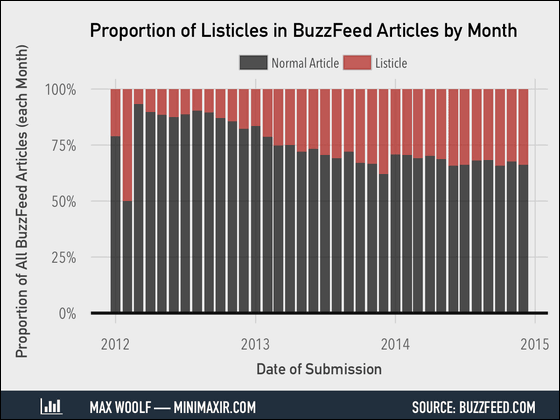
Furthermore, the following table examines the distribution of the number of items covered by list articles. ToFiveMethod "and" seen in15 piecesCharacteristics of the article "as shown in the graph, but it seems that listing of about 10 to about 25 items per article is common in general. The average overall value was "19 pieces".
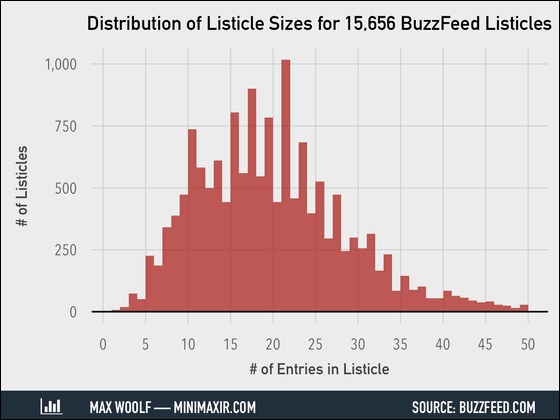
Furthermore, the graph below plots the number of times that article was shared on Facebook for each item number. From the black graph showing the average, it is found that there are tendencies that list articles with 30 to 35 items tend to be most frequently shared, and in particular, it is seen that the number of shares of 15 or fewer articles is largely depressed You can take it. Please note that the numerical value on the Y axis is a logarithmic scale and the actual opening is much larger.
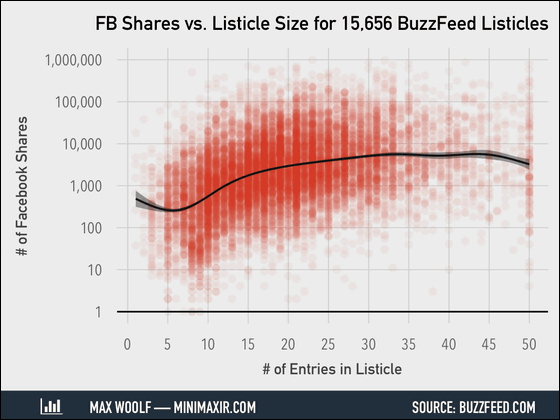
It seems that changes are seen also in the classic phrase of the article title. The following table lists the most frequently used phrases per month, and the [x] part contains numbers.
From 2012 to 2013, "The 13 Coolest Tattoo Artists In The World(13 coolest tattoo artists in the world) "like"The (number) ~"There were many patterns, but around the year 2014"12 Things Men Can Do That Women Can not(12 things that men can do but not women) "like"(Numbers) things ~"And" things "as the subject is becoming mainstream. It is also thought that there is an aim to eliminate the hard atmosphere by removing "the".
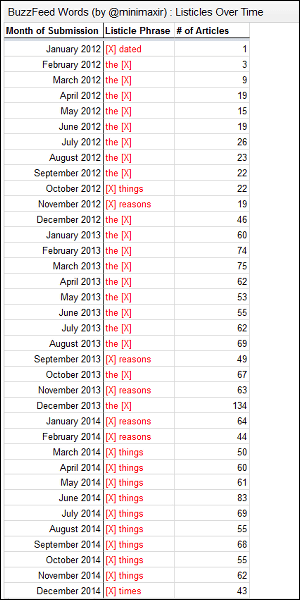
Sorting out the number of times she shared on Facebook with the contents of the article looks like this. The numerical values indicate the average value, and the gray bar indicates the distribution of the number of shares. First place is "28 Pictures That Will Make You Laugh Every Time(28 pictures of funny laughter every time I see it) "like"(Numbers) pictures ~In the pattern of "(Number) insanely ~(Example:23 Insanely Clever Ways To Eat Cauliflower Instead of Carbs(Super clearable 23 way to eat cauliflower instead of carbohydrates) ","(Numbers) words ~(Example:22 Words That Have A Totally Different Meaning In The South(22 words whose meaning changes completely when going to the southern part of America) "and so on.
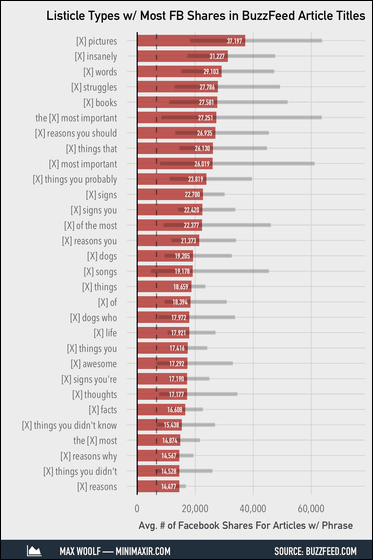
◆ Most shared keywords
Looking at keywords that are most shared by each period, the keywords that were most noticed at that time are highlighted. In 2012 when the presidential election took place, you can see that the keywords of "obama (President Obama)" and "romney (candidate Romney)" overwhelmed the other in contested elections. Besides that, words such as "boston (Boston)", "halloween (halloween)", "gay (gay)" appear more than once.
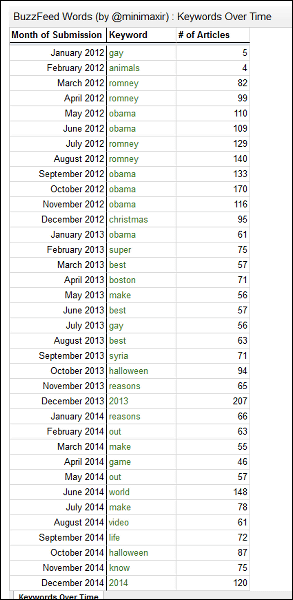
It is like this if you compare the number of times you shared for each keyword. It is clear that articles that include keywords such as "career", "which" and "kind" tend to be shared.

◆ Three-word keyword
In addition, Mr. Wolf investigated by enlarging the target of the keyword into a chunk composed of three words, and conducted an analysis reflecting the content of the article more. Here, "The (number) mostYou can see that there are many phrases such as "most (one ~) one" and "you need to".

And the number of times shared by each 3 word keyword is as follows. Among them, the most prominent "character are you" is "Which Harry Potter Character Are You(Which characters are you character in Harry Potter?) "Or"Which Pixar Character Are YouIn an article like "Which one is Pixar's character," it is thought that the number of shares has increased since it is an article that leads the reader to choose options and leads the results . Also, it seems that there is a tendency to share as more titles as intellectual curiosity like "before you die" or "you probably do not" I will come.
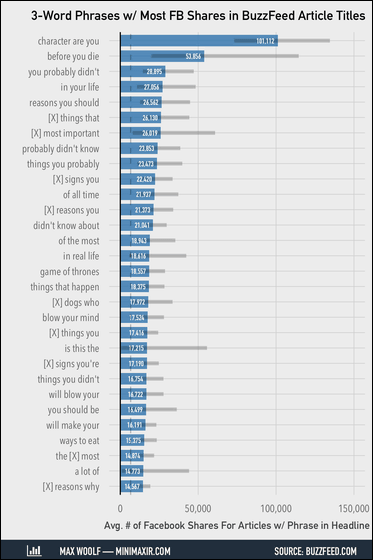
Related Posts:
in Note, Web Service, Posted by darkhorse_log







